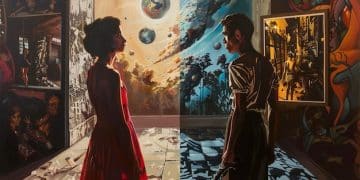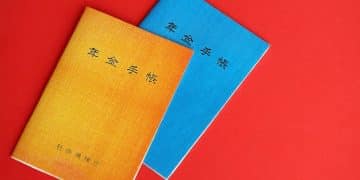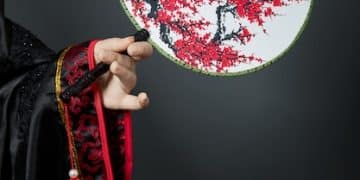Japanese Drama Manga Adaptations: Which Series Stay True to the Source Material?
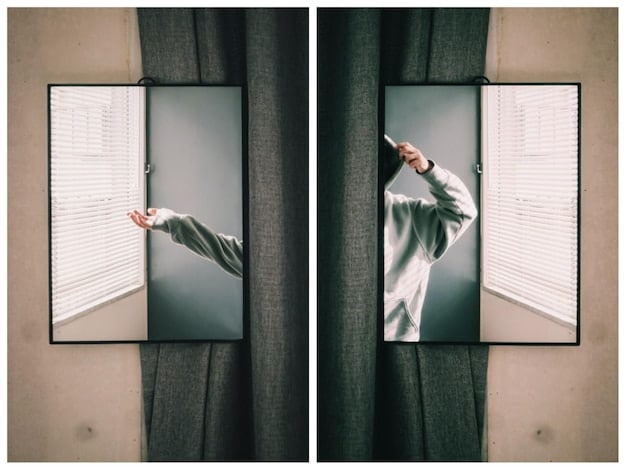
Advertisements
Japanese drama manga adaptations vary in their faithfulness to the source material, with some series closely following the original storyline and character development, while others take creative liberties for television.
The world of Japanese dramas, often called J-dramas, is rich with adaptations of popular manga series. But how closely do these Japanese drama manga adaptations stick to their original stories? Let’s dive in and explore which series are the most faithful.
Anúncios
The Allure of Manga Adaptations in Japanese Drama
Manga adaptations have become a staple in the world of Japanese dramas. These adaptations bring beloved characters and stories to life on screen, attracting both fans of the original manga and new viewers alike. But why are manga such a popular source for J-dramas?
Popularity of Manga as Source Material
Manga offers a wealth of compelling narratives and characters that resonate with a wide audience. For drama producers, adapting a popular manga provides a built-in fanbase and a proven storyline, reducing the risk of creating original content.
Anúncios
Challenges in Adapting Manga to Live-Action
Despite the advantages, adapting manga to live-action comes with its own set of challenges. The visual style, pacing, and even the often exaggerated expressions of characters in manga can be difficult to translate effectively to the screen.
- Maintaining the essence of the original story while making it appealing to a broader audience.
- Casting actors who can embody the unique characteristics of the manga characters.
- Balancing faithfulness to the source material with the need for creative adaptation.
Successfully adapting manga to drama requires a delicate balance of staying true to the original work while making necessary changes to fit the medium of television. The best adaptations capture the spirit of the manga and offer a fresh perspective on familiar stories.
Faithful Adaptations: Series That Stay True
Some Japanese drama adaptations are known for their remarkable faithfulness to the source material. These series often prioritize accuracy in plot, character portrayal, and even visual style. What are some examples of these faithful adaptations?
“Nodame Cantabile”
“Nodame Cantabile” is a prime example of a manga adaptation that stays incredibly true to the original. The drama captures the quirky humor and heartwarming moments of the manga, making it a hit with fans.
“Hana Yori Dango”
Another faithful adaptation is “Hana Yori Dango,” which tells the story of a poor girl attending a prestigious school dominated by a group of wealthy and influential boys. The drama closely follows the manga’s plot and character arcs.
- Close adherence to the original storyline.
- Accurate portrayal of characters’ personalities and relationships.
- Visual elements that closely resemble the manga’s art style.
These adaptations prove that it’s possible to create a successful drama while honoring the vision of the original manga creator. By staying true to the core elements of the story, these series have garnered praise from both manga fans and drama enthusiasts.
Creative Liberties: When Dramas Deviate from Manga
Not all Japanese drama adaptations stick strictly to the source material. Some series take creative liberties, altering plot points, character details, or even the overall tone of the story. Why do some dramas choose to deviate from the manga?
Reasons for Deviation
There are several reasons why a drama might deviate from its manga source. Sometimes, changes are made to streamline the story for television or to appeal to a wider audience. In other cases, the drama might explore themes or characters that were only hinted at in the manga.
Examples of Dramas Taking Liberties
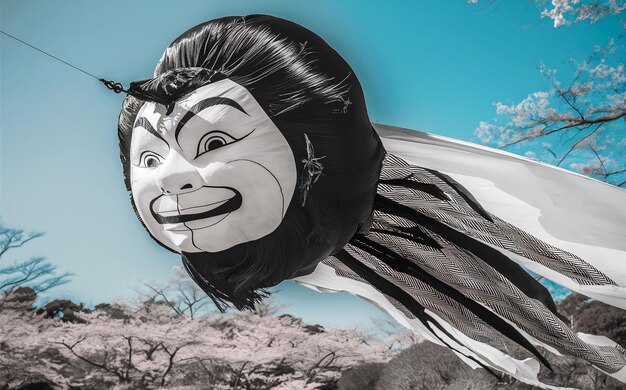
One example of a drama that takes liberties with its source material is [Insert Drama Title Here, if applicable]. While the drama retains the basic premise of the manga, it introduces new characters, plot twists, and even changes the ending.
- Changes made to streamline the plot for television.
- Introduction of new characters or storylines.
- Alterations to character personalities or relationships.
While some fans may be disappointed by these deviations, others appreciate the fresh perspective and new interpretations of familiar stories. Ultimately, the success of a drama that takes liberties depends on how well it balances respect for the source material with the need for creative adaptation.
Character Portrayal: Actors Embodying Manga Characters
One of the most crucial aspects of a successful manga adaptation is the casting of actors who can embody the unique characteristics of the original characters. How do casting directors find the right actors to bring these beloved characters to life?
The Importance of Casting
Casting is essential because the actors’ performances can make or break a manga adaptation. Fans often have strong opinions about who should play their favorite characters, and casting choices that deviate too far from expectations can lead to backlash.
Examples of Successful Casting Choices
Some actors have become synonymous with their manga-inspired roles. For example, [Insert Actor Name Here] perfectly captured the essence of [Insert Character Name Here] in [Insert Drama Title Here]. Their portrayal was so well-received that it became a benchmark for future adaptations.
Finding actors who not only look the part but also understand the nuances of their characters is a challenging but rewarding task. Successful casting can elevate a manga adaptation from a simple retelling to a truly memorable and engaging viewing experience.
Visual Style: Recreating the Manga Aesthetic
The visual style of a manga is often a defining characteristic, and many drama adaptations attempt to recreate this aesthetic on screen. From costumes to set design, visual elements play a crucial role in capturing the essence of the original work. How do dramas approach this challenge?
Costumes and Set Design
Costumes and set design are key components in recreating the manga aesthetic. Dramas often use vibrant colors, exaggerated styles, and unique props to mirror the visual world of the manga. Attention to detail is essential in creating a believable and immersive experience for viewers.
Special Effects and Cinematography
Special effects and cinematography can also be used to enhance the visual style of a manga adaptation. Some dramas use visual effects to recreate the exaggerated expressions and movements of manga characters, while others employ creative cinematography techniques to capture the dynamic energy of the original work.
By paying close attention to visual details, drama adaptations can successfully transport viewers into the world of the manga and create a visually stunning and engaging viewing experience.
Fan Reception: Balancing Expectations and Adaptations
Ultimately, the success of a manga adaptation depends on how well it is received by fans. Balancing the expectations of longtime manga readers with the needs of a broader television audience can be a delicate balancing act. What are some common fan reactions to manga adaptations?
Positive and Negative Reactions
Positive reactions often focus on the drama’s faithfulness to the source material, the quality of the acting, and the overall entertainment value. Negative reactions, on the other hand, may stem from deviations from the manga, casting choices that don’t meet expectations, or a perceived lack of respect for the original work.
Finding the Right Balance
The key to a successful manga adaptation is finding the right balance between honoring the source material and making necessary changes for television. By understanding the expectations of fans and carefully considering the needs of a broader audience, dramas can create adaptations that are both faithful and engaging.
Future Trends: What’s Next for Manga Adaptations?
Manga adaptations continue to be a popular and evolving trend in Japanese drama. As production techniques and storytelling approaches continue to evolve, what can we expect to see in the future of manga adaptations?
Technological Advancements
Technological advancements are likely to play a significant role in future manga adaptations. Virtual reality, augmented reality, and other immersive technologies could be used to create more interactive and engaging viewing experiences.
Fresh Storytelling Approaches
We may also see fresh storytelling approaches that push the boundaries of what’s possible in manga adaptations. Dramas may experiment with different narrative structures, explore new themes, or even incorporate elements of fan fiction into their adaptations.
The future of manga adaptations is bright, with endless possibilities for innovation and creativity. By embracing new technologies and storytelling approaches, dramas can continue to captivate audiences and bring beloved manga stories to life in exciting and unexpected ways.
| Key Aspect | Brief Description |
|---|---|
| 📚 Faithful Adaptations | Series that closely follow the original storyline and character development. |
| 🎨 Creative Liberties | Dramas that alter plot points, character details, or even the overall tone. |
| 🎭 Character Portrayal | The casting of actors who embody the unique characteristics of the manga characters. |
| 🎬 Visual Style | Recreating the manga aesthetic through costumes, set design, and special effects. |
FAQ
▼
A successful adaptation often balances faithfulness to the source material with creative adaptation to fit the medium of television. It also requires strong casting and attention to visual details.
▼
Dramas may deviate to streamline the story, appeal to a wider audience, or explore themes not fully developed in the manga. This can offer a fresh perspective.
▼
Casting is crucial, as actors must embody the unique characteristics of manga characters. Good casting can elevate the adaptation, while poor casting can lead to negative reactions.
▼
Visual style is key in recreating the manga aesthetic. Costumes, set design, special effects, and cinematography help transport viewers into the manga’s world.
▼
Future trends include technological advancements like VR and AR, as well as fresh storytelling approaches that push creative boundaries and offer innovative viewing experiences.
Conclusion
Exploring the world of **Japanese drama manga adaptations** reveals a spectrum of approaches, from faithful recreations to creative reinterpretations. Each series offers a unique perspective on beloved stories, inviting viewers to immerse themselves in the captivating world of Japanese drama.
